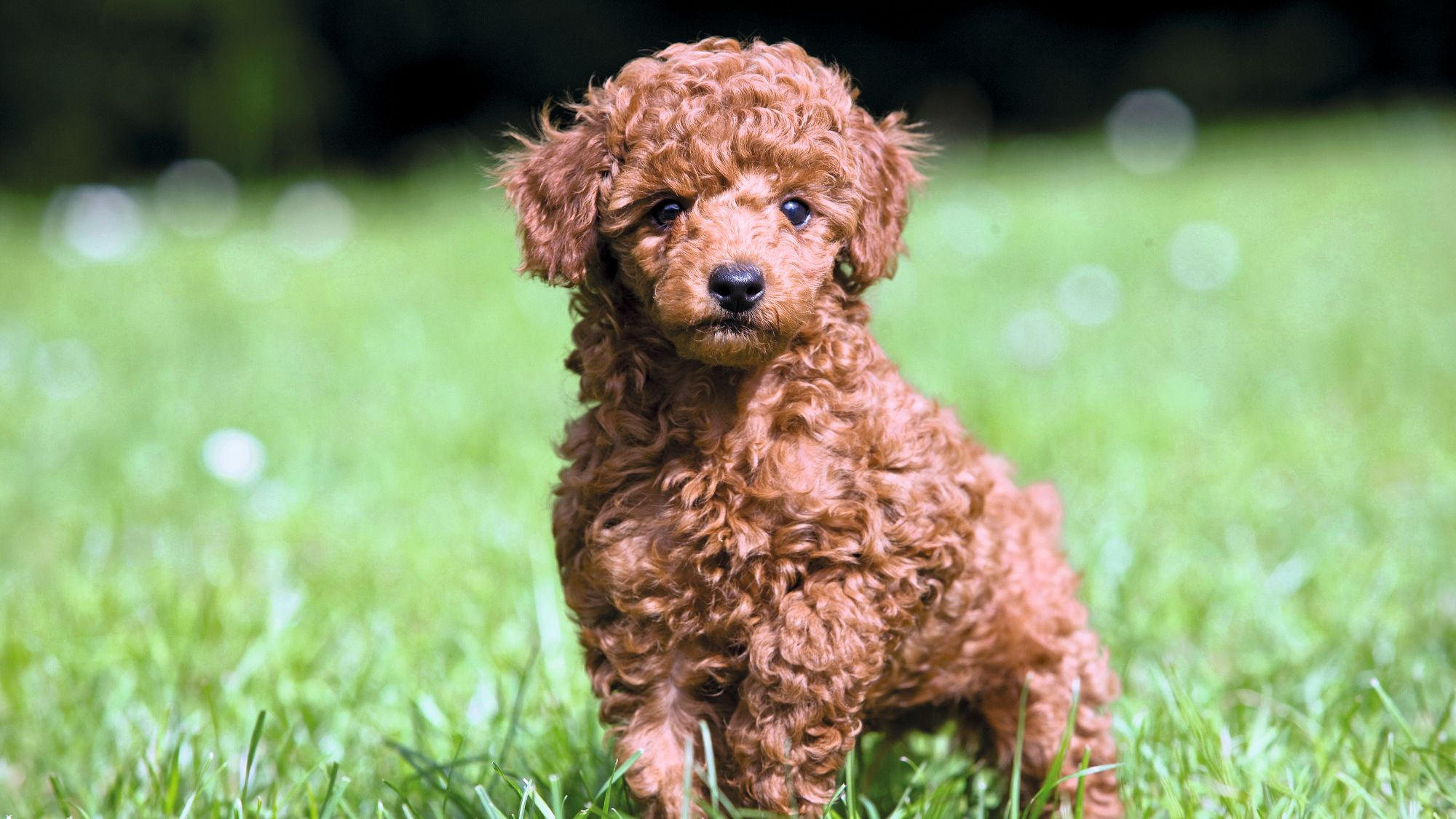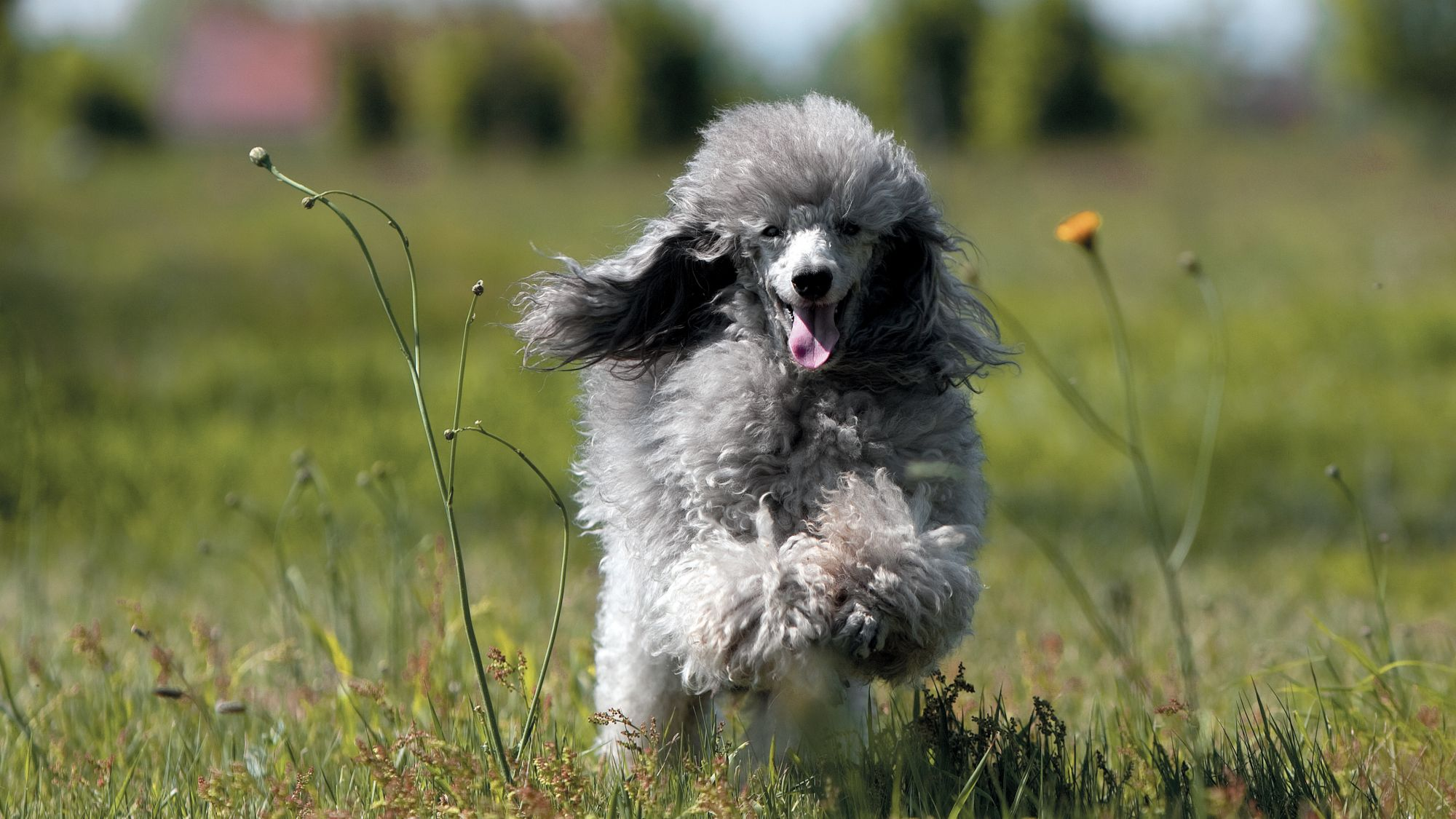Let's talk Poodles
That agile gait, the regal demeanour, those enviable coiffes. You might take Poodles for the supermodels of the dog world; however, there is much more to this very old breed than meets the eye. Once bred for water fowling, Poodles are natural athletes and inherently task oriented. Whether it’s the Toy, Miniature or Standard variety, these top-of-the-class-clever dogs excel in various roles, from show dogs to therapy animals. Their distinctive curly fur and proud posture make them stand out in any crowd. So, it's no surprise that Poodles are cherished worldwide for their beauty and brains.
Official name: Poodle
Other names: Caniche (France)
Origins: Germany
Drooling tendencies
1 out of 5Grooming needs
5 out of 5Shedding Level
1 out of 5Barking tendencies
2 out of 5Energy level
3 out of 5Compatibility with other pets
4 out of 5Warm weather?
3 out of 5Cold weather?
3 out of 5Suited to apartment living
4 out of 5Can be left alone
3 out of 5Family pet
4 out of 5
| Male | Female |
|---|---|
| Height | Height |
| 152 - 165 cm | 140 - 152 cm |
| Weight | Weight |
| 13.6 - 18.1 kg | 10 - 14.5 kg |
| Life Stages | |
|---|---|
| Puppy | Adult |
| 2-12 months | 12 months to 5 years |
| Mature | Senior |
| 5 years to 8 years+ | From 8 years |
| Baby | |
| Birth to 2 months | |
Tailored nutrition for your Poodle

Get to know the Poodle
All you need to know about the Poodle
Originally used by European hunters to retrieve game from streams and lakes, Poodles are highly alert, eager to please, and task-driven. With an English name derived from the German word for splashing about in water, and a French name, Caniche, that comes from “cane,” meaning female duck, it’s no surprise that these dogs are excellent jumpers and swimmers.
Misconceptions about their disposition are usually based on their distinct “clips” or grooming styles, which once had the practical purpose of keeping vital areas warm with longer hair while clipping other areas short to allow for ease of movement in water. Of course, there is also an aesthetic intention behind that eye-catching look, as Poodles have been favoured companions of the fashion-focused for centuries and are regular competitors and winners in dog shows.
Poodles are keenly sensitive and adapt very well to people. This, combined with their substantial energy, means they thrive on attention and commands. With firm training and regular exercise, Poodles make excellent companions that are well-behaved around children and other animals.

Two facts about Poodles
1. A history of utility and elegance
Poodles were originally bred as water retrievers, and their name comes from the German word "Pudel," meaning "to splash in water." Their distinctive grooming style, featuring shaved legs and a pom-pom tail, was designed to help them move more efficiently in the water while protecting vital organs and joints from the cold.
2. They require their beauty sleep
It just wouldn’t be fair if these knockout pooches got to be striking, smart, and athletic all with only a short night’s sleep. In fact, Poodles really like their shut-eye, with puppies getting around 15 hours of snooze time per day and adults around 12-13 hours per day. So, don’t be surprised if your Poodle gets in more than forty winks - being this beautiful takes rest!²
History of the breed
Established in Germany as a breed used for bird hunting and water retrieval over four centuries ago, the Poodle’s name comes from the German word “pudel” or “pudelin,” meaning to splash around in water. The Poodle’s trainability, athletic prowess, and well-proportioned build quickly made them a sought-after breed.
Poodles became so popular that breeders began producing smaller versions—the Miniature followed by the Toy—each suited to different roles and environments. The French used the Standard Poodle for hunting, while tasking the medium-sized Miniature with truffle hunting and the Toy with being a companion to the upper echelons of society.
In 1874, England’s Kennel Club registered its very first Poodle, and the American Kennel Club followed soon after, registering them in 1886. However, the breed didn’t enjoy solid success overseas until after World War II, reaching peak popularity in the 1950s and enjoying a two-decade run as the country’s preferred pup.
Nowadays, the popularity of Poodles have seen a huge increase with them becoming one of the most popular dog breeds in the US as they make excellent family pets and companions.
From head to tail
Physical characteristics of the Poodle
1.Head
2.Face
3.Body
4.Tail
5.Fur

Things to look out for
From specific breed traits to a general health overview, here are some interesting facts about your Poodle
Excitement or something more?
Poodles are naturally athletic and highly active, so it isn’t surprising when they take it up a notch and launch into zoomies - that behaviour when they start racing around and around in circles. However, if the running seems more nervous than excited, they might be experiencing a seizure. There are many potential causes for seizures, so a quick trip to the vet as soon as you notice anything unusual will help you catch anything early.
Look out for signs of hip dysplasia
Like many breeds, Poodles can suffer from the genetic disorder known as hip dysplasia, a condition where the femur slides partially out of the hip socket due to the malformation of the latter. Potential signs include decreased movement, “bunny hopping” gait, and or reluctance to run, jump, or climb stairs. If left unchecked, hip dysplasia can develop into arthritis and, eventually lameness. The good news is regular X-rays and check-ups with your vet give you a head start in supporting your dog and ensuring best possible care.
Keep an eye open for eye issues
Another condition observed in some Poodles, particularly in the Miniature and Toy varieties, is PRA – progressive retinal atrophy. PRA encompasses a range of eye diseases that can cause the retina to gradually deteriorate. An early manifestation of PRA is night blindness, which can sometimes cross over into the day. Remember to ask your vet for a PRA Optigen DNA test, which will help you stay on top of any potential concerns.
Tailored nutrition for Poodles

When choosing food for a Poodle, there are many factors to consider: their age, lifestyle, activity level, physiological condition, and health, including potential illnesses or sensitivities. Food provides energy to support a dog’s vital functions, and a complete nutritional formula should contain a balanced mix of nutrients to avoid any deficiencies or excesses, both of which could have adverse effects on the dog.
Immune System Support
As puppies grow, they will experience big changes and new discoveries. During this key period, the puppy's immune system develops gradually. Poodle Puppy helps support your puppy's natural defences with an exclusive complex of antioxidants including vitamin E.
Coat Health
Coat condition is a reflection of a dog's state of health and overall well-being. Formulated with omega-3 fatty acids (EPA & DHA) and a precise protein content, this puppy formula helps maintain the Poodle's woolly coat and continuous hair growth.
Digestive Health
Formulated with high-quality protein (L.I.P.*) and prebiotics to support digestive health and a balanced intestinal flora, contributing to optimal stool quality. *Protein selected for its very high digestibility.
Exclusive Kibble
This exclusive kibble has been developed to be perfectly adapted to the jaw of the Poodle puppy, making it easy to pick up and chew.

The main nutritional goals for adult Miniature Poodles are:
Coat Health
Skin and coat health is a reflection of the dog's state of health and overall well-being. Poodle Adult is formulated with nutrients to help maintain the health of the poodle's curly, woolly coat. Enriched with omega-3 fatty acids (EPA and DHA) and precise protein levels, this formulation supports continuous hair growth.
Healthy Aging Support
The Poodle is known for their long life span. Poodle Adult helps support the Poodle throughout their lifetime, even into maturity, with a selection of nutrients to maintain health and vitality.
Muscle Tone
This formula helps maintain the Poodle's muscle tone with a precise protein content.
Exclusive Kibble
The Poodle has a long, straight muzzle with teeth that meet in a scissors bite. The kibbles of Poodle Adult have been designed to make it easy for this breed to pick up and chew.

The main nutritional goals for aging Poodles are:
After 8 years old, Miniature Poodles start facing the first signs of aging. Aging is also accompanied by the modification of digestive capacities and particular nutritional requirement. Therefore, a formula enriched with antioxidants will help maintain their vitality and an adapted phosphorus content will support their cardiac health. Also, food for older Miniature Poodles should have the following characteristics:
Healthy Aging Complex
Poodle Adult 8+ is formulated with a precise phosphorus content and an exclusive complex of antioxidants to help maintain optimal health in maturing Poodles.
Coat Health
Nutrition plays an important role in maintaining the quality of the skin and coat. Poodle Adult 8+ is formulated with EPA & DHA and a precise protein content to support healthy hair growth for this breed's curly coat.
Heart Health
The Poodle Adult 8+ formulas contain a blend of nutrients, including taurine and EPA & DHA, to help maintain cardiac health in mature Poodles.

Caring for your Poodle
Grooming, training, and exercise tips
Poodles' sharp intelligence, athletic predisposition and profound desire to please makes them very easy to train. In addition, early training and socialization helps them channel their abundant supply of energy and curb any predisposition to possessiveness. As they are highly responsive, reward-based training with treats and/ or favourite toys is an excellent approach to teaching them. Poodles enjoy being around people and need a fair amount of exercise. A Poodle that is left alone for long periods of time could turn toward destructive behaviour. Remember, a busy Poodle is a thriving Poodle!
Poodles are a non-shedding breed with thick, curly, even wiry hair that can be styled to suit a broad range of owner tastes. However, grooming a Poodle is a serious commitment as it is recommended that they be professionally groomed every 3 to 6 weeks. Another positive of regular grooming is that it helps prevent various health issues (e.g., dermatitis) and allows for thorough health checks.
Poodles excel in training due to their intelligence and eagerness to please. Early socialization and consistent, positive reinforcement methods will help them develop into well-mannered adults. It is recommended that your Poodle enjoy a minimum one to three hours of exercise a day. Since they benefit greatly from activities, long walks, jogs, retrieving, and swimming are just a few great ways to help Poodles channel all of that energy. Also, they enjoy learning new tricks and can be trained for various dog sports.
7/7
All about Poodles
While they are considered “moderate” barkers, Poodles never bark for no reason. Those reasons can include being left alone for long periods of time, passersby, excitement, etc. Luckily, this breed responds extremely well to solid, early training and can learn to stifle that bark.
In a word, yes. While they like to stay active during the days and are independent, an aspect that Poodle owners appreciate about the breed, Poodles have another side to them and are generally up for a good snuggle with their humans when the day is done.
Read more on this topic
Sources
- 1- AKC
- 2 - Poodle Behaviour
- Banfield Pet Hospital https://www.banfield.com/
- Royal Canin BHN Product Book
- American Kennel Club https://www.akc.org/
Like & share this page